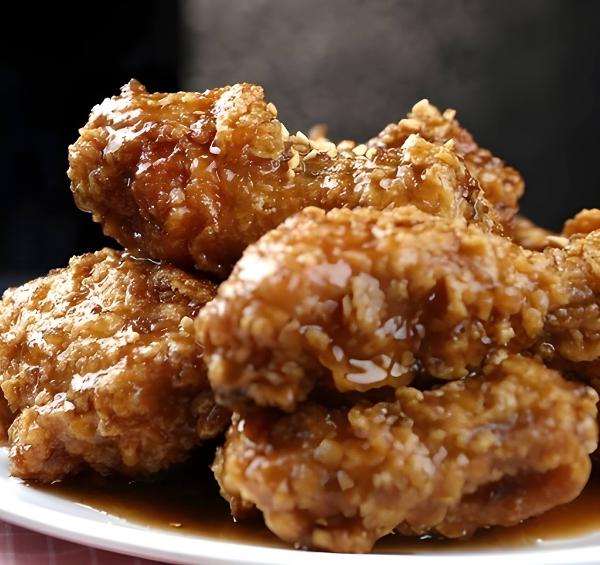What Makes Korean Fried Chicken So Different?

If you've ever bitten into a piece of Korean Fried Chicken (KFC), you know it's an experience unlike any other. It's not just chicken; it's a culinary phenomenon that has taken the world by storm. But what exactly sets this crispy delight apart from its American or other global counterparts?
It all comes down to a few key, deliberate steps that transform simple fried chicken into something truly special. Let's dive into the delicious differences!
1. The Legendary Double Fry: Achieving Peak Crunch
This is arguably the most crucial difference and the secret behind the chimaek (a combination of chicken and beer) star's legendary texture.
The American Way (Often): Typically, Southern-style fried chicken is fried once until golden brown and cooked through.1
The Korean Way (The Magic): K Chicken is fried twice.
Why the double fry?
First Fry (Lower Temp): The chicken is fried at a lower temperature to cook the meat through without burning the exterior.
The Rest: The chicken rests briefly, allowing excess moisture to escape.3
Second Fry (Higher Temp): It's fried again quickly at a much higher temperature.4 This second blast of heat drives out nearly all the remaining surface moisture, resulting in an incredibly thin, light, and shatteringly crisp crust that stays crunchy for much longer. It's less "battered" and more "glass-like."
2. The Batter: Thin and Starchy Magic
The coating itself plays a massive role in that signature texture.
Flour vs. Starch: While many Western styles rely heavily on a thick, seasoned flour-based batter, Korean Fried Chicken often uses a very thin batter heavily reliant on starch, usually a mix of potato starch or cornstarch, and sometimes rice flour.
The Result: This starch-forward mixture creates a lighter, finer, and less dense crust when fried.5 It adheres tightly to the chicken, creating that paper-thin crispiness rather than a thick, breaded shell.
3. The Sauces: Flavor Bombs That Stick
This is where the variety truly shines, and it's a significant departure from the simple seasoning-only approach or the heavy, gravy-style coatings sometimes seen elsewhere. KFC is often served tossed in a glaze immediately after the final fry 6
The two titans of KFC flavor are:
Yangnyeom (양념): The classic, sweet, and spicy sauce.7 It's a beautiful balance of gochujang (Korean chili paste), soy sauce, garlic, ginger, vinegar, and sugar or honey.8 It coats the chicken without immediately making it soggy.
Ganjang (간장): A savory, soy-garlic flavor profile. It's salty, umami-rich, and often carries a subtle sweetness, typically accompanied by generous amounts of minced garlic.9
The key takeaway here is that these sauces are applied after the frying process, which helps maintain the crunch longer than if the chicken were deep-fried in the sauce (as is often the case with American-style wings).
4. Cut and Presentation: More Meat, Less Bone
If you've ordered KFC in Korea, you might notice a difference in what you receive:
Whole Pieces vs. Wings: While wings are popular, KFC establishments often sell bone-in pieces (such as thighs and drumettes) that are sometimes cut after cooking, similar to how you might order a whole roast chicken.
Boneless Options: The abundance of boneless options, often called sunsal (살살 - meaning tender/soft), is enormous.10 These are typically chunks of white meat that are battered and fried with the same high standard of crispiness.
The Verdict: It's a Symphony of Texture and Taste
Korean Fried Chicken is different because it is an intentional study in texture contrast. You get:
Feature Korean Fried Chicken (KFC) Traditional American Fried Chicken (General Comparison)
Frying Method: Double-fried (High Heat Second Fry, usually single-fried
Crust Texture Thin, light, exceptionally crispy "shatteri"g" Thicker, more substantial, often craggy or flaky
Coating Base: High starch content (potato/cornstarch), Higher flour content
Flavor Finish Often tossed in a sticky glaze (Yangnyeom, Ganjang). Often seasoned before/after frying, sometimes served plain or accompanied by a dipping sauce on the side.
It’s a commitment to that super-crisp exterior that can withstand a flavor-packed sauce, making every single bite a perfect interplay between crunch, juiciness, and flavor!
What part of the Korean Fried Chicken experience interests you the most? Would you like me to find a highly-rated recipe for a classic Yangnyeom sauce?